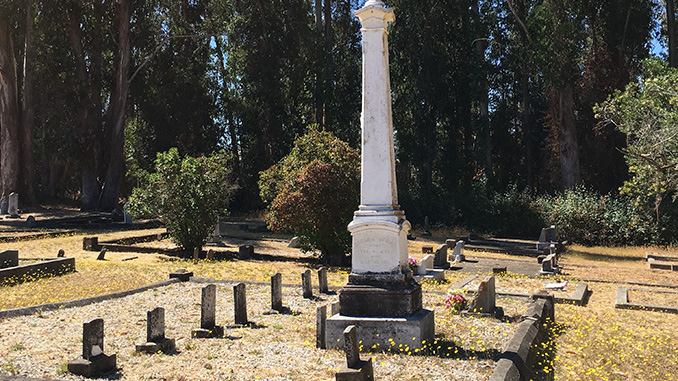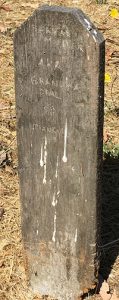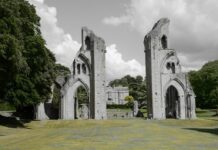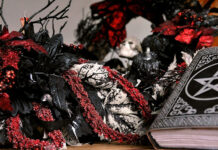
- 163shares
- Facebook157
- Twitter3
- Pinterest3
- Reddit0
- 0
- views
- Like
- Digg
- Del
- Tumblr
- VKontakte
- Buffer
- Love This
- Odnoklassniki
- Meneame
- Blogger
- Amazon
- Yahoo Mail
- Gmail
- AOL
- Newsvine
- HackerNews
- Evernote
- MySpace
- Mail.ru
- Viadeo
- Line
- Comments
- Yummly
- SMS
- Viber
- Telegram
- Subscribe
- Skype
- Facebook Messenger
- Kakao
- LiveJournal
- Yammer
- Edgar
- Fintel
- Mix
- Instapaper
- Copy Link
Two Rock Valley Presbyterian Church Cemetery is a little country graveyard, maybe an acre or two in size. It’s hemmed in by trees on two sides and looks out across rolling farmland on the third. One the north side stands a low brown church with a simple steeple.
I pass the cemetery on my way to my favorite spa, a Japanese bathhouse called Osmosis where the tubs of hot water have been replaced by huge wooden boxes full of cedar shavings and brown rice meal, where you cook in the heat of the compost. It smells heavenly. I’ve been going there for decades.
Usually, though, I’m in a tearing hurry to get there. Although the spa is only 60 miles north of the Golden Gate Bridge, traffic always gets snarled somewhere along the way. It’s common for an hour-and-a-half drive to swell to three or four hours.
This time, I’d left myself four hours for the drive and everything flowed. As I navigated the two-lane road swooping up and down over the golden California hills, I realized that, at last, I had time to stop in the graveyard.
Pioneers came to the Two Rock Valley around 1850. Probably they came out for the California Gold Rush and realized they could make a better living farming. In the early days, potato farms dominated the area. Now it’s ranch land, roamed by dairy cows. I could hear them in the distance.
Two Rock Valley Presbyterian Church dates to 1860, when a pastor was assigned to the area. The first burials in the graveyard date to 1861.
Rumor indicates that some Chinese may be buried outside the cemetery fence on the west side, amongst the trees. They probably worked on the local farms. Because of the Chinese Exclusion Act, Chinese women could not immigrate to the US until 1943. Most Chinese men who worked in America planned to stay long enough to send some money back home. If they died in California, they were buried in temporary graves until their flesh could fall away. Then other members of their community were meant to exhume their remains, scrape the bones clean, and bundle them up to be shipped back to China, so they could rest with their ancestors.
If the Chinese community died out or was driven away before that could happen, the remains would be left behind and forgotten. None of the Chinese graves had permanent markers, since the graves weren’t intended to be permanent. Often these graves lie outside the cemetery fences, since it was all too common for Chinese to be excluded from Christian cemeteries.
A wildfire in 1949 not only demolished the old church but also destroyed the cemetery records. Because of that, it’s uncertain how many people are buried in the graveyard. The US Army started the fire on their property west of the church. It had been meant to be a controlled burn, but in the dry grassland, it was quickly slipped control.
As I roamed around the cemetery, scrub jays scolded me. First one, then the other shrieked, letting everyone in the area know that an interloper wandered their graveyard. I never saw the jays, but I saw plenty of sparrows and purple finches.
 I discovered graves still marked by wooden planks. In California’s early days, graves often had no more marker than a redwood board. Redwood is resistant to insects, long-lasting, and cheap. Not everyone could afford a granite marker from the Sierras. Marble had to be imported from the East Coast or Italy – and before the cross-continental trains, it had to be shipped around the tip of South America. Even if a marble monument was ordered, names and dates were painted on planks to mark the grave until the permanent marker arrived.
I discovered graves still marked by wooden planks. In California’s early days, graves often had no more marker than a redwood board. Redwood is resistant to insects, long-lasting, and cheap. Not everyone could afford a granite marker from the Sierras. Marble had to be imported from the East Coast or Italy – and before the cross-continental trains, it had to be shipped around the tip of South America. Even if a marble monument was ordered, names and dates were painted on planks to mark the grave until the permanent marker arrived.
Not many of the old wooden markers have survived the last century and a half, so I’m always thrilled to find one.
I was framing a photograph when the jays suddenly fell silent. The quiet unnerved me. I eyed the trees crowding the west and south sides of the graveyard, wondering about mountain lions. I knew it would be rare for a lion to be hunting in the brightness of the morning. I also knew you never see them until they pounce. Still, I was closer to the woods than to my car – and there wasn’t a soul within screaming distance. I edged back toward the church, never turning my back on the trees.
Overhead, a red-tailed hawk screeched. It wheeled above me, hunting for a sparrow or a fence lizard. When none of the little animals broke cover, the hawk soared off into the cloudless sky.
Once it was gone, the jays squawked again, brave once more.










